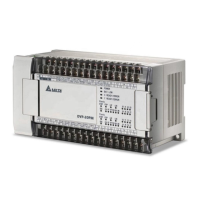5 Applied Instructions and Basic Usage
b. RightCAM
After the slave axis specified is started, it will stop for a while, and then execute rotary cut. After the
rotary cut is complete, the slave axis will stop for a while, and then continue executing the rotary
cut.
CLR0 will be ON after the slave axis moves to the synchronization zone designed. After the slave
axis leaves the synchronization zone designed, CLR0 will be OFF. When CLR0 is ON, its external
LED indicator will not be ON. If users want to check whether CLR0 is ON, they can connect CLR0
to any general input terminal.
c. midCAMbegin, midCAMall, and midCAMend: The three types of curves need to be used together.
Position of the master axis
Ratio of the speed
of the slave axis
specified to the
speed of the master
axis specified
(1)
(2) (3) (4)
(5)
The slave axis specified executes rotary cut four times, and then stops. There are five phases.
Phase 1: The slave axis specified is at a standstill, and then begins to execute rotary cut until
the first object is cut. The curve created is midCAMbegin.
Phase 2: After the cutter used cuts the first object, it returns to its preparatory position, and then
accelerates until it moves to its cutting position. The curve created is midCAMall.
Phase 3 and phase 4: The motion in phase 2 is repeated.
Phase 5: After an object is cut, the cutter used returns to its preparatory position. The curve
created is midCAMend.
The three types of curves need to be used together, and the DynamicGen input pin needs to be set
to True.
If users create a rotary cut curve in this way, CLR0 will not be ON after the slave axis specified
moves to the synchronization zone designed.
DVP-20PM Application Manual
5-222

